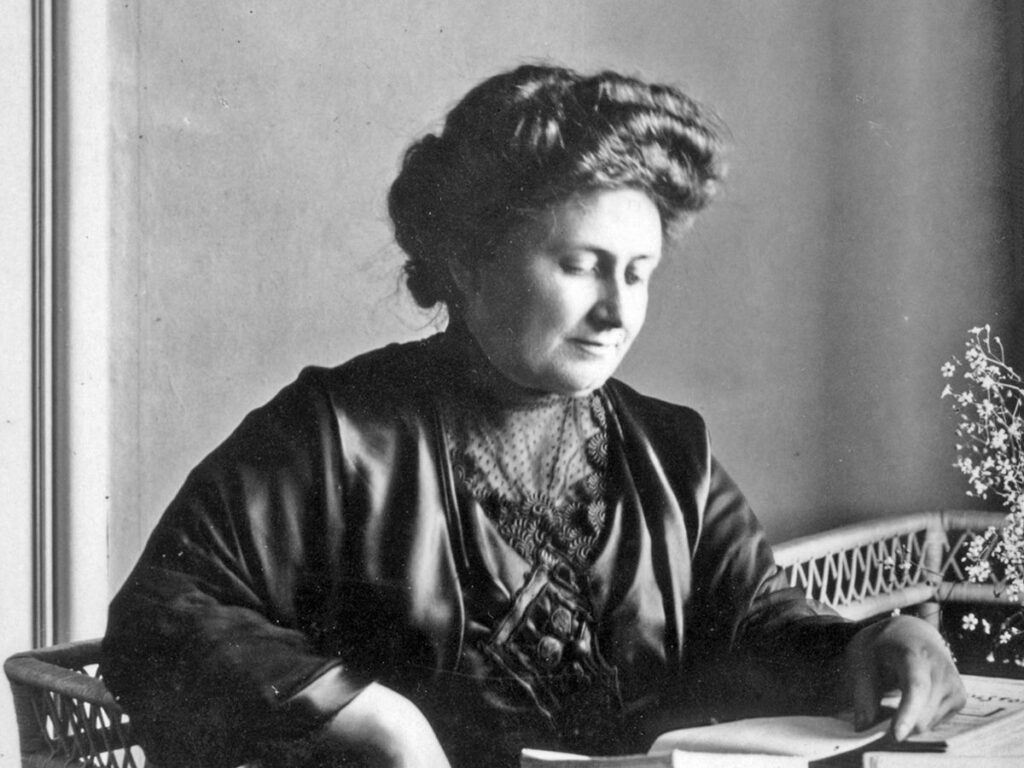A 1913 photograph of Maria Montessori
Public domain via Wikimedia Commons
Maria Montessori stood before a crowd of 60 underprivileged children, her students. It was January 6, 1907, and the 36-year-old educator was opening her first school: the Casa dei Bambini, or “Children’s House,” a preschool that would revolutionize children’s education.
“I had a strange feeling which made me announce emphatically that here was the opening of an undertaking of which the whole world would one day speak,” Montessori later recalled.
Today, the legacy of the Italian woman behind Montessori schools lives on in preschools around the globe. But at the time, the theory that providing children with stimulating activities would help them more than rote learning and academic drills was revolutionary.
Kindergarten students at a Montessori school in Hamburg, Germany
Public domain via Wikimedia Commons
Though her innovations inspired a movement in young children’s learning, Montessori saw her work more simply. “I did not invent a method of education,” she wrote in 1914. “I simply gave some little children a chance to live.”
Montessori was passionate about education from a young age. Born in 1870 and raised in Rome, she took a path that defied the era’s expectations for women. Montessori studied engineering, then applied to medical school at the University of Rome, telling a professor during her interview, “I know I shall become a doctor.” The school refused her, so Montessori enrolled in the general university; studied physics, mathematics and natural sciences; and reapplied to medical school. She was admitted, becoming the first woman to enter the university’s Faculty of Medicine, and in July 1896, she became one of Italy’s first female doctors.
Montessori’s medical work led her to the University of Rome’s psychiatric clinic. As part of her job, she visited asylums for children with mental disorders, searching for patients eligible for treatment at the clinic. It was here that her interest in child development intensified. She read extensively about children with learning differences, including the writings of Jean-Marc-Gaspard Itard, a 19th-century French physician who worked with deaf children and the “wild boy of Aveyron,” a teenager who’d famously raised himself in the woods.
In 1898, Montessori spoke at Italy’s National Medical Congress in Turin, advocating for the idea that lack of adequate provisions and care for children with mental and emotional disorders caused them to misbehave. She continued her advocacy at the 1899 National Pedagogical Congress, where she proposed special training for teachers working with special-needs children—a component of her idea that better education would lead to social progress.
Montessori’s interest in early childhood education strengthened over the next few years. She developed her own teaching materials, and in 1907, she opened her first school.
Her method revolved around engagement. Though Montessori introduced her students to many activities and materials, she retained only those the kids were interested in. She realized that activities could help children socially develop, and she theorized that, surrounded by such activities, students could educate themselves. Montessori’s self-dubbed “auto-education” approach soon had the 5-year-olds at Casa dei Bambini reading and writing.
Maria Montessori receives an honorary doctorate in 1950.
Public domain via Wikimedia Commons
News of Montessori’s success spread quickly, and by 1908, her name was known around the world. By the fall of 1908, five Case dei Bambini were operating in Italy. Her method soon crossed borders as kindergartens in Italian-speaking Switzerland adopted her methods. A couple of years later, Montessori published a book, The Montessori Method, which was printed in English in the United States in 1912; over time, it would be translated into 20 different languages. In the following decades, Montessori schools and teacher training programs sprang up around the world.
Before her death in 1952, Montessori was nominated for the Nobel Peace Prize several times, though she never won it. She lived to see her educational theories enacted around the globe, as more and more “awakened” children—as she called activity-stimulated students—successfully learned their letters.
As Montessori biographer E.M. Standing notes, Montessori proved that the “awakened” child “develops a higher type of personality—more mentally alert, more capable of concentration, more socially adaptable, more independent and at the same time more disciplined and obedient—in a word, a complete being—a ready foundation for the building up of a normalized adult.”
“This is Montessori’s great achievement,” Standing writes, “the ‘discovery of the child.’”


